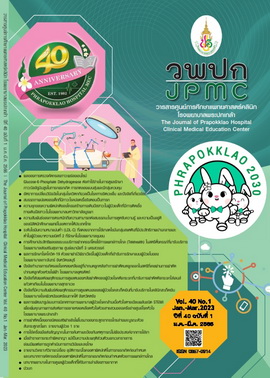Results of Glucose-6-phosphate Dehydrogenase Deficiency Screening Related to Medical Expenses in Neonatal Hyperbilirubinemia: A Randomized Controlled Trial
Main Article Content
Abstract
BACKGROUND: Glucose-6-phosphate dehydrogenase deficiency (G6PD deficiency) is one of the risk factors of hyperbilirubinemia neurotoxicity. Nevertheless, G6PD screening is inaccessible at general hospitals throughout Thailand. The threshold for initiation of phototherapy in infants with risks of hyperbilirubinemia neurotoxicity is lower than for infants without risk. Practically, newborn infants with unknown G6PD status would be assumed to have G6PD deficiency until proven otherwise. Therefore, unnecessary phototherapy and hospital costs occurs when infants are later found to be G6PD normal.
OBJECTIVES: To compare whether G6PD screening at birth from cord blood could decrease the early use of phototherapy and medical expenses.
METHODS: A single-blind randomized controlled trial was conducted in neonates born at 35 weeks of gestation or later at Burapha University Hospital between October 2021 and March 2022. Neonates were randomly assigned to either a cord blood G6PD screening group or control group. Infants’ medical expenses during 14 days of life were evaluated.
RESULTS: Two hundred forty-one neonates were randomized to either a cord blood G6PD screening group or control group. Two hundred thirty-nine neonates, including 121 in the cord blood G6PD screening group and 118 in the control group, completed the intervention. Total medical expenses during 14 days of life in the cord blood G6PD screening group was insignificantly higher than in the control group (425 vs 350 Baht, p=0.03). The number of neonates in the cord blood G6PD screening group who received phototherapy was lower than the control group (15.7% vs 22.9%, p=0.16). Among the neonates who received phototherapy, the subthreshold phototherapy rate in the cord blood G6PD screening group was significantly lower than in the control group (26.3% vs 66.7%, p=0.007).
CONCLUSIONS: G6PD deficiency screening at birth can decrease the subthreshold phototherapy rate but increase medical expenses.
Thaiclinicaltrials.org number, TCTR20220705006
Article Details

This work is licensed under a Creative Commons Attribution-NonCommercial-NoDerivatives 4.0 International License.
References
Bawazeer M, Alsalamah RK, Almazrooa DR, Alanazi SK, Alsaif NS, Alsubayyil RS, et al. Neonatal hospital readmissions: rate and associated causes. J ClinNeonatol 2021;10:233-8.
Young PC, Korgenski K, Buchi KF. Early readmission of newborns in a large health care system. Pediatrics [Internet]. 2013 [cited 2021 Jan 2];131(5):e1538-44. Available from: https://doi.org/10.1542/peds.2012-2634
American Academy of Pediatrics Subcommittee on Hyperbilirubinemia. Management of hyperbilirubinemia in the newborn infant 35 or more weeks of gestation. Pediatrics 2004; 114:297-316.
Maisels MJ, Bhutani VK, Bogen D, Newman TB, Stark AR, Watchko JF. Hyperbilirubinemia in the newborn infant≥ 35 weeks’ gestation: an update with clarifications. Pediatrics 2009;124:1193-8.
Isa HM, Mohamed MS, Mohamed AM, Abdulla A, Abdulla F. Neonatal indirect hyperbilirubinemia and glucose-6-phosphate dehydrogenase deficiency. Korean J Pediatr 2017;60:106-111
Atasilp C, Kanjanapipak J, Vichayaprasertkul J, Jinda P, Tiyasirichokchai R, Srisawasdi P, et al. Associations between UGT1A1 and SLCO1B1 polymorphisms and susceptibility to neonatal hyperbilirubinemia in Thai population. BMC pediatr [Internet]. 2022 [cited 2022 June 15];22:1-8. Available from: https://bmcpediatr.biomedcentral.com/articles/10.1186/s12887-022-03311-4
Khemtonglang N, Kitcharoen S, Kiatchoosakun P, Dechyothin S, Kleesuk C. Relationship between glucose-6-phosphate dehydrogenase deficiency and UGT1A1 geno-types in neonates with hyperbilirubinemia. Southeast Asian J Trop Med Public Health 2017;48:655-61.
Wickremasinghe AC, Kuzniewicz MW, McCulloch CE, Newman TB. Efficacy of subthreshold newborn phototherapy during the birth hospitalization in preventing readmission for hototherapy. JAMA Pediatr 2018;172:378-85.
Taylor JA, Chang PW. Initiating phototherapy at subthreshold levels: the slippery slope. JAMA Pediatr 2018;172:322-4.
Watchko JF. Subthreshold phototherapy during birth hospitalization may prevent readmission for phototherapy. J Pediatr 2018;198:322-5.
Cheepsunthorn CL, Nuchprayoon I. G6PD deficiency in Southeast Asia and G6PD diagnostic tests in support of primaquine treatment to eliminate malaria. Chula Med J 2014; 58:153-68.
Cheepsunthorn CL, Nilsri N. Prevalence of glucose 6-phosphate dehydrogenase deficiency and molecular genetics of G6PD in Thai population of Phayao province. J Hematol Transfus Med 2015;25:131-7.
Palacajornsuk P, Sriwangpon P. Prevalence of glucose-6-phosphate dehydrogenase deficiency (G-6-PD) using methemoglobin reduction test in blood donors of Chiang Mai Province. J Assoc Med Sci 2015;48(1):29-33.
Nuchprayoon I, Sanpavat S, Nuchprayoon S. Glucose-6-phosphate dehydrogenase (G6PD) mutations in Thailand: G6PD Viangchan (871G>A) is the most common deficiency variant in the Thai population. Hum Mutat [Internrt]. 2002 [cited 2021 Jan 2];19(2):185. Available from: https://onlinelibrary.wiley.com/doi/epdf/10.1002/humu.9010

